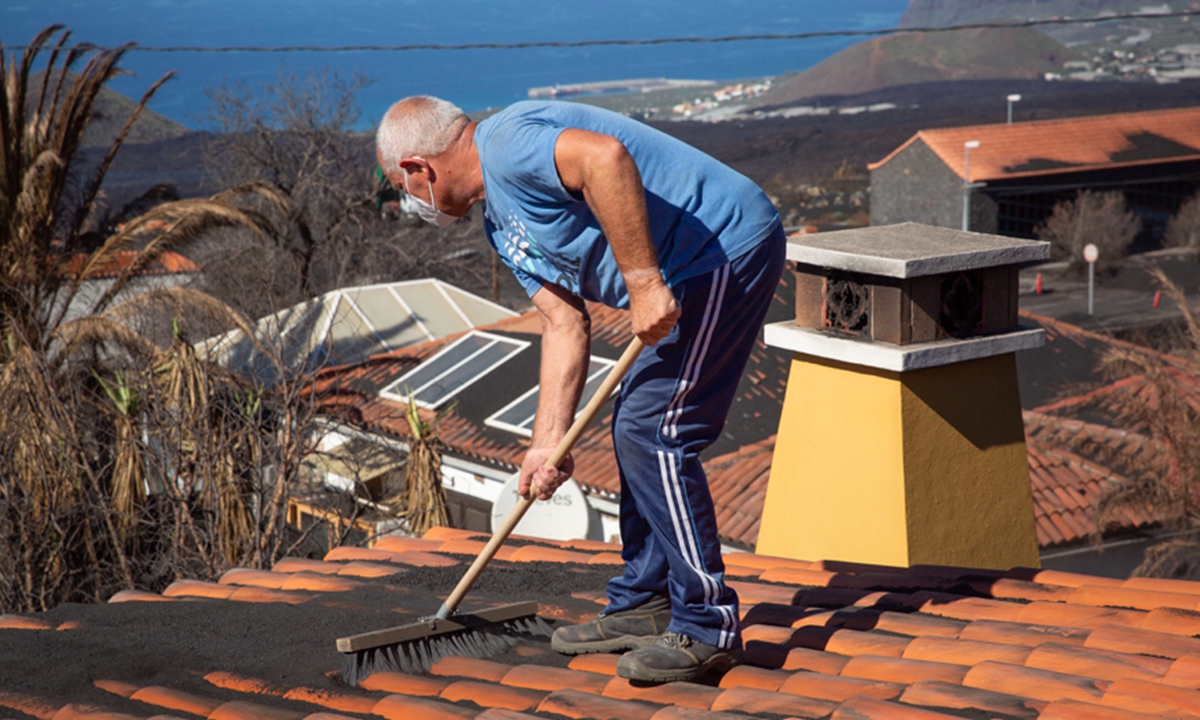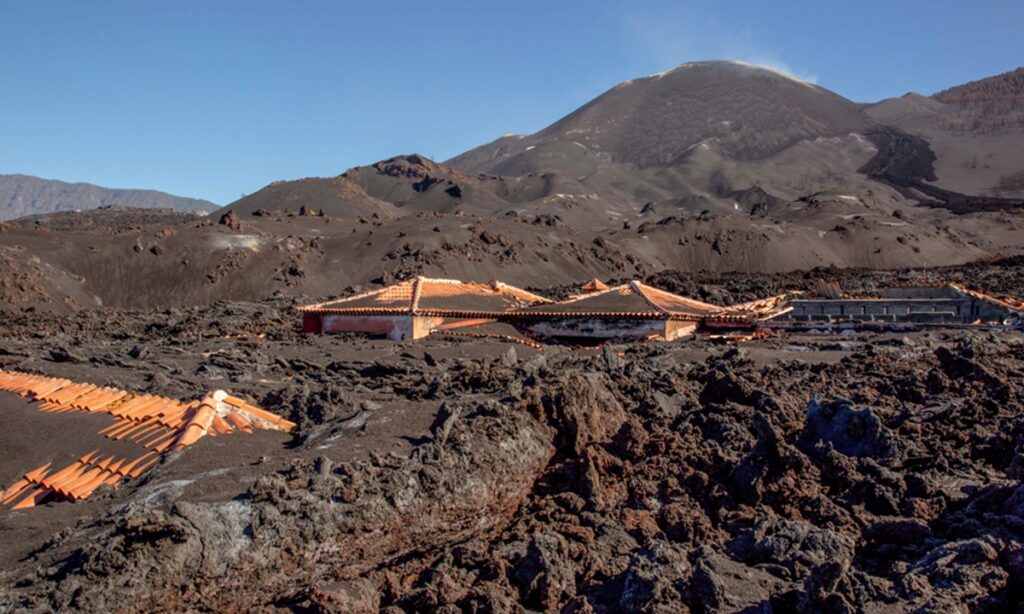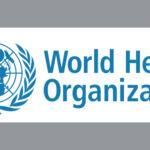Spain volcano island residents return home to battle ash

A man removes ashes from the roof of his house due to the consequences brought by the eruption of Cumbre Vieja volcano on the Spanish Canary Islands of La Palma on January 4, 2022. Photos: AFP
For weeks they dreamt of returning to the homes they fled when a volcano erupted on the Spanish island of La Palma.
Now that they are finally trickling back to them, their joy is tempered by finding everything covered in a sea of ash.
“It’s another world,” said Felix Rodriguez, a 61-year-old bricklayer, as he swept ash from the roof of his house to the terrace below.
He was one of around 1,000 people who were allowed to return to their homes this week, out of a total of 7,000 who were evacuated after the Cumbre Vieja volcano erupted on September 19, 2021, spewing lava and thick plumes of ash into the air.
But like many of the others, he won’t be able to move back into his home right away.
In addition to blocking doors and paths with piles of ash, lava from the eruption damaged pipes, leaving him without running water.
The lava has also blocked a key road in the Aridane valley, forcing area residents to take much longer routes around the island for trips for basic services that used to take just five minutes.
While the red-hot lava miraculously spared Rodriguez’s home, it engulfed the neighboring cemetery, leaving only a few tombs visible.
‘Horrible’
Spanish authorities declared the eruption officially over on Christmas Day in 2021 following 10 days of no lava flows, earthquakes or significant gas emissions.
No injuries or deaths have been directly linked to the eruption on the tiny isle, part of the Canary Islands which lie off Africa’s northwest coast.
But it destroyed over 1,300 homes, mainly on the western side of La Palma, and covered 1,250 hectares of land, including vineyards and plantations of bananas and avocados.
Carmen Acosta, 57, is one of the lucky few who were able to sleep in their home again for the first time after living in a hotel for over three months.
Her parents, who are in their 80s, live with her in the bright blue, one-story house that is surrounded by fruit trees and has a sweeping view of the Atlantic Ocean.
“We have a lot of things to clean,” said Acosta, as she was surrounded by plastic bags full of clothes, food and medicines which the family brought with them.
“Even in six months, it won’t be finished. There is a lot of ash, a lot of garbage… It’s horrible.”
In the affected area, mounds of ash engulf orange and apple trees, making them look like shrubs.
‘Joy but helplessness’
Gladys Jeronimo, a recently retired 65-year-old housekeeper, had looked forward to resting after decades of work.
“But for now this is all there is: sadness and cleaning and cleaning,” she said as she swept her porch.
Jeronimo said she felt “a lot of joy and helplessness at the same time.”
“Joy because it’s over, but helplessness because we can’t come back” permanently, since running water has not yet been restored, she said.
Her neighbor Maria Zobeida Perez Cabrera, a 68-year-old caregiver, said her second home, which used to belong to her parents, was “horrible, like a graveyard,” because everything was covered in black ash.
“Everything around us was black, there was no soil, no roof, even the plants were black,” she said as she loaded a wheelbarrow with ash.
Ruben Lopez, a geologist with the Spanish geographical Institute, said winds will blow “much” of the ash into the sea.
While the surface of the lava has cooled, the flows “still store a lot of heat,” he added.
“This will last weeks, even months, and in addition they release gases,” he said.
It will be easier to build on top of lava that has cooled than to remove it, he added.
The last time the Cumbre Vieja, meaning “old peak” in Spanish, erupted was in 1971 when the eruption occurred at the southern end of the volcano.
The nature of the volcanic eruption was considered strombolian, or a volcanic eruption with mild blasts of about one to two on the Volcanic Explosivity Index.
In contrast, the eruption before that of 1971 which occurred in 1949 was so severe that residual thermal emissions continue to this day.
‘Throwing in the towel’
Like thousands of others, Jorge Diaz Hernandez does not know when he will be allowed to return to his home.
“This is the million euro question,” the 36-year-old said with a shrug at a mountaintop lookout in the municipality of Los Llanos de Aridane.
During the eruption he came regularly to this spot to see if the banana plantation he has run for the past decade had been affected.
It was spared the lava, but Diaz estimated it will take three years to restart production because of the ash damage.
“I am throwing in the towel, I will dedicate myself to something else,” he said.
“I was already tired of the way agriculture and bananas are treated, the low prices, the cost of water, all that. This is the straw that breaks the camel’s back,” he added.
This is the latest calamity to hit Spain as the country struggled with high COVID-19 cases for most of 2020 and part of 2021. But the tiny island’s residents’ optimism might be a sign of a changing tide.
The houses damaged by the lava flow following the eruption of the Cumbre Vieja volcano on the Spanish Canary Islands of La Palma that began on September 19, 2021 Photo:AFP




